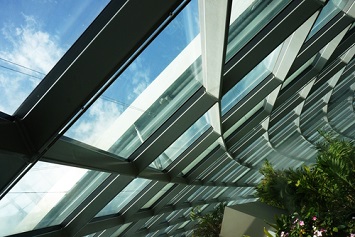Employees and occupants can spend hours at a time inside your facility, so the quality of the indoor air is an important factor in their health and performance on the job. Poor indoor air quality (IAQ) can lower worker productivity, increase missed days of work, and lead to adverse health effects. Building occupants can experience short-term effects, including irritation of the eyes, nose, and throat; headaches; and dizziness. Over time, occupants can develop respiratory diseases, heart disease, or even cancer. There is no specific Occupational Safety and Health Administration (OSHA) IAQ standard to protect worker health, but California and New Jersey have developed standards that apply in some cases. (For details, check out our previous article.)
During a facility’s normal operation, IAQ is affected by pollutant sources (e.g., fuel-burning appliances, tobacco smoke, building materials, and cleaning products), inadequate ventilation, and outdoor air that enters the building (i.e., infiltration). Notably, conducting maintenance and renovation activities can generate harmful dust, moisture, and volatile organic compounds (VOCs), seriously degrading IAQ. However, there are actions a facilities manager can take to mitigate the degradation of IAQ during maintenance and renovation in order to protect the health and well-being of all building occupants.
HVAC Protection
It’s important to prevent debris from entering the heating, ventilation, and air conditioning (HVAC) system through ducts. Once in the system, pollutants can be transported throughout the building, thus exposing more people; it will also degrade the system’s overall performance.
- If the HVAC system is being operated during renovation, install temporary filters on all return air system openings. The American Society of Heating, Refrigerating and Air-Conditioning Engineers (ASHRAE) Standard 52.2-2007 specifies that filters with a Minimum Efficiency Reporting Value (MERV) of 8 should be used at each return air opening. Before occupancy, the normal filters should be replaced.
- If activities that produce a large amount of dust (e.g., drywall sanding, cutting concrete, and sawing wood) are being performed inside, seal off return air system openings.
- If the HVAC system is not operated during renovation, seal off both the supply and the return air system openings to prevent accumulation of dust. Also, seal diffusers in plastic.
- Keep pollutant sources (e.g., paints, sealers, adhesives, caulking, cleaners) as far away as possible from supply openings.
- Inspect ducts frequently throughout the duration of renovation to ensure the above control measures are adequately protecting them. If the ducts are contaminated, consider contracting a professional cleaning service.
Isolate the Work Area
Isolate areas of work to prevent the contamination of clean or occupied areas.
- Use dust curtains or temporary enclosures to prevent pollutants from traveling to other areas of the building.
- Set up a pressure differential to prevent air in the working space from entering other areas.
- Work performed outdoors, like roofing, can still generate odors and pollutants that affect IAQ. When possible, locate sources away from air intakes, and consider wind patterns before work is performed. Ensure windows of the building are closed.
- Workers performing maintenance and renovation activities should be careful not to spread pollutants throughout the building by wearing contaminated personal protective equipment (PPE).
Housekeeping Is Key
Have an effective housekeeping routine.
- Suppress dust with wetting agents or sweeping compounds. Collect dust with a damp cloth, wet mop, vacuum, or wet scrubber.
- Clean up any spills immediately. Protect absorptive materials (e.g., gypsum wall board, carpets) from moisture damage. When exposed to moisture, these materials can grow mold or microbial contaminants, which can cause adverse health reactions in building occupants, including allergic reactions, asthma attacks, and rashes.
Minimize VOCs
- Avoid finishes, furniture, and cleaning products that off-gas high levels of VOCs. Look for products that are certified by a third party to ensure adherence to emissions requirements, such as GREENGUARD or FloorScore. VOC exposure can lead to irritation and central nervous symptom effects.
- Some materials act as sinks that absorb VOCs readily. Schedule the sequence of renovation activities to minimize absorption. For example, if applying paint, let it dry in a well-ventilated area before installing carpeting.
- Keep containers of wet products closed. Cover or seal waste materials.
Other Control Measures
- Try to schedule the renovation when the building is not occupied. Relocate occupants in the affected area to another part of the building. Notify building occupants of the renovation activities before starting.
- Use electric equipment instead of equipment that runs on gasoline or diesel-powered equipment so that carbon monoxide (CO), a combustion product, is not produced. If using gas-powered equipment, do not operate near air intakes. Equipment should be turned off when not in use.
- If your building is undergoing lead paint or asbestos remediation, licensed and certified contractors are required to perform the removal or abatement. These contractors are trained on how to avoid creating lead dust, or disturbing the asbestos so that it becomes airborne.
Flush Out Before Occupancy
- When renovation activity is complete, install new HVAC filter media, and conduct a building flush-out.
- Consider performing air quality testing to determine the pollutant levels, such as particulate matter, formaldehyde, CO, and total VOCs in the air. You can perform testing quickly and cheaply with handheld sensors, but for more accurate measurements, air samples can be captured and sent to a laboratory for analysis.
LEED IAQ Maintenance and Renovations Policy
Is your existing building pursuing a Leadership in Energy and Environmental Design (LEED) Operations and Maintenance certification? In the LEED v4.1 Existing Buildings Operations and Maintenance (EBOM) rating system, all projects must meet the Facility Maintenance and Renovations Policy requirements. To do so, a policy must address IAQ, as well as purchasing and waste management considerations. For the IAQ part of the policy, there can be a single plan for maintenance activity, but an individual plan for each renovation project must be created. The policy must follow the control measures (chapter 3) in the Sheet Metal and Air Conditioning National Contractors Association (SMACNA) IAQ Guidelines for Occupied Buildings under Construction, 2nd edition (2007).

